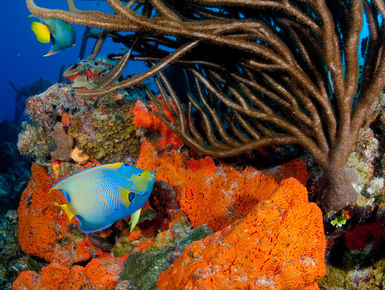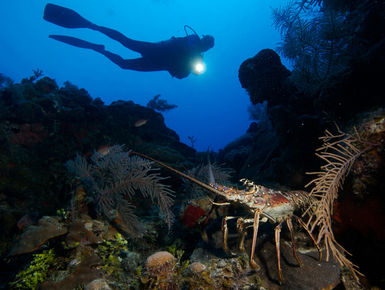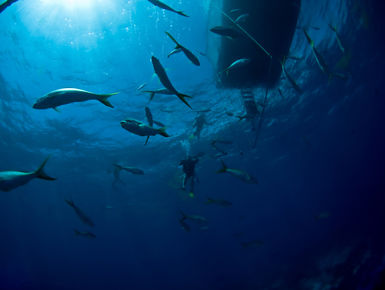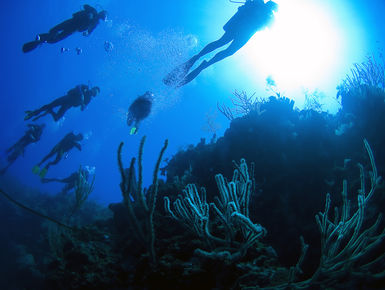
Clear Waters and Big Walls
In the islands of the Turks & Caicos, expansive undersea plateaus end in coral-dense cliff faces that drop abruptly from the shallows to depths of a mile or more. This is the land of the multi-level profile, where bottom times culminate with extended stays in sunlight shallows. To complete the picture, add in consistently stellar water clarity, a smattering of historic and modern wrecks, and thousands of acres of coral heads and shallow reefs. Beachfront resorts on the island of Providenciales offer a full range of perks and indulgences; liveaboards cruise to remote and pristine reefs; and Grand Turk provides a step back in time.
Highlights
- Best for: All Divers
- Best season to visit: Year Round, January to March for whales, summer for reef sharks
- Weather: The islands sit at the northern edge of the trade wind belt, and too far south to be affected by Continental cold fronts. Temperatures have minor seasonal variations from the low to mid 80s, and occasional passing rain showers in summer
Things to Do
- • Whale watching
- • Flats & deep sea fishing
- • Stand up paddle boarding
- • Mangrove kayak tours
- • Kiteboarding
- • Thursday fish fry
Turks & Caicos Information
About Diving in Turks & Caicos
The islands of the Turks & Caicos are the high points of large underwater plateaus that rise from the deep water. Island beaches and coastlines may face extensive shallows filled with coral heads, or transition into spur-and-groove coral reefs that slope downward to depths of 40 to 60 feet before turning into steep walls that can drop thousands of feet. As a result, most dive sites are either coral gardens or finger reefs leading to a vertical face. Water temperatures range from 79 to 83 degrees.
Diving in Turks & Caicos Tips
The region’s clear waters allow sunlight to penetrate deeper, reducing the sense of depth on wall dives. Be sure to monitor depth gauges on a regular basis to avoid going too deep. A good plan is to drop directly to the deepest planned depth, then sight see on the way back up and extending the dive by off-gassing in shallower water.
Best Places to Dive in Turks & Caicos
Look for reef sharks and rays cruising between coral heads at Pinnacles. At Elephant Ear Canyon, one of the site's namesakes sponges measures more than ten feet across. The reward at Pot of Gold isn't precious metals but the rainbow of colors that light the reef. When conditions are right, dolphins, rays and sharks cruise through Sandbore Channel. The overhanging wall at Black Coral Forest provides the perfect habitat for large coral trees to flourish. A trip to the Devil's Horn isn't a punishment, and if you hit the G Spot you'll find yourself in thick schools of fish and dense gorgonian groves.
What to Pack for Diving in Turks & Caicos
A 3mm wetsuit and a camera, because the clear waters and abundant light make everyone a good photographer. Don't bother with a flash, and go for a normal to wide lens to get the big picture of dive buddies and sharks.
Liveaboards

Turks and Caicos
Turks and Caicos Explorer II
The vessel offers 3 stateroom categories including two VIP staterooms, an air-conditioned main salon, large sundeck for lounging, and an awning covered flybridge as well. You won’t go hungry as our chefs serve breakfast, lunch, dinner, snacks, and desserts along with alcohol and non-alcoholic beverages.
There are up to 5 dives a day, where you will likely see reef sharks, macro critters, spotted eagle rays, grouper, turtles, and more. And if you can fit it in, island shore excursions can be arranged when possible. This energetic, fun crew will take great care of you!
Book on-line or Contact Caradonna Adventures at 800-330-6611 or email us sales@caradonna.com.
Call 800-330-6611 for Special Pricing and Information.
See Packages & Learn MoreDiving in Turks & Caicos
The Turks and Caicos islands are made up of 40 islands and small cayes, with most of the resort development centered on the island of Providenciales, which is often called Provo. From shops in the Grace Bay area, dive operators make quick runs to an expansive area of spur-and-groove coral formations that drop from depths of 30 to 100 feet. These reefs are dominated by star and pillar corals and covered in sea rods and gorgonians. Profiles are relaxing and suitable for all divers, and in summer month there is a good chance of seeing reef sharks, as pregnant females move into the warm, protected waters of the bay to rest while gestating. This area is also a favorite for night dives. A bit farther from shore, a large seamount rises from deep water to within 45 feet of the surface. The top and sides of this formation are cut by exaggerated coral ridges and valleys that attract a wide range of sea life, including groupers that pause at cleaning stations along the reef crests. A half hour run to the west, Provo's Northwest Point is a realm of swim-throughs, caverns and canyons that lead to steep walls. This area is known for abundant fish life and includes many of the island's signature sites, with names such as Thunderdome, Chimney, The Crack, Hole in da Wall, Shark Hotel, Black Coral Forest. After free-falling down vertical cliffs covered in a huge barrel and orange elephant ear sponges, tube sponges and in many places black coral trees, divers can thread their way back upward through indentions, chimneys and splits in the wall that lead to shallow reefs where bottom times can be stretched to upwards of an hour. Liveaboards and day boats making an all-day trip will find some of the most dramatic walls along the shores of uninhabited West Caicos and tiny French Cay. In addition to a full range of reef species, these sites offer eagle rays, turtles, sharks and passing pelagics, including rare but possible sightings of manta rays, blue sharks and whale sharks. More consistent are the gray reefs that cruise the middle depths. The humpback whales that migrate through these waters rarely come close enough to the walls to be seen, but their songs can often be heard by divers. The island of Grand Turk sits 22 miles to the east of the Caicos Bank, across a 7,000-foot deep channel that rises abruptly to depths of less than 40 feet just a short way off Grand Turk's white sand beaches. This puts prime dive sites within a very quick boat ride from shore. More than just a straight drop, this wall is perforated by wide canyons and amphitheater-like indentions, with surfaces riddled with arches, overhangs, outcroppings and caverns. This twisted topography supports a rich range of reef species and prolific growths of soft corals and sponges.
Passport and/or Visa Requirements
Entry/Exit Requirements: All U.S. citizens are required to present a passport, and do not need to obtain a visa. All persons leaving the T&C, pay a Government Departure Tax which should be included in your International Airline ticket cost.
Immunizations
Vaccinations are not required for entry into the T & C. Check with your doctor and the Centers for Disease Control on recommended vaccinations for travel at cdc.gov.
Culture and Customs
Don't expect volcanoes, waterfalls and palm trees when you arrive in the Turks & Caicos. These low-lying islands are about white sand beaches, the sun and some of the clearest waters in the western hemisphere. Situated midway between the Bahamas and the Caribbean, they were never major trading ports , and planters struggled and failed to establish crops in the dry, sandy soil. However, the two elements the islands had in abundance—salt water and sun—became the basis for a prosperous industry, which involved flooding large shallow lagoons that evaporated into acres of dry salt that could be raked up and shipped around the world. With the demise of the salt industry in the 1960s, the islands seem destined to sink into obscurity. The change began with the arrival of the first beach resorts in the 1980s, followed by a nascent offshore banking industry. Today, the rewards of finance and tourism are apparent on the island of Providenciales, while outlying islands retain the low-key charm of years past. History buffs can visit the former strongholds of British Loyalists on islands like North Caicos, and reminders of the salt-raking era are evident in the remains of salina walls, windmills and warehouses, all free for wandering. Music lovers can discover the unique genre known as rake-and-scrape, which can often be heard at the fish fries held each Thursday night at Provo's Bight Park. This island-wide gathering is also a good time to shop for iconic sea glass jewelry and take in the weekly Junkanoo parade.
Electricity, Phone and Internet Access
Electricity is 120V, 60 Hz, so no adapter is needed for electronic devices for U.S. visitors. The country/area code for Turks & Caicos is 649. Check with your cell phone provider to see what options are available for International plans. Internet service is available at most hotels and many restaurants.
Water Quality
Some resorts may offer purified water, however, the CDC recommends drinking bottled water.
Language & Currency
English is the official language of the Turks & Caicos Islands. The official currency is the U.S. Dollar. Most resorts and restaurants accept credit cards and ATMs are available.
Time
The Turks and Caicos are on Atlantic Standard Time (AST) and stopped observing Daylight Savings Time in 2015. The Turks & Caicos are 4 hours behind Greenwich Mean Time (-4 GMT).
Location, Size and Population
The Turks and Caicos Islands are 550 miles Southwest of Miami, just south of the Bahamas chain and east of Cuba. The islands consist of roughly 40 islands, only 8 of which are inhabited. The islands encompass approximately 365 square miles. Middle Caicos includes the largest islands of Providenciales, approximately 47 square miles, North Caicos, approximately 45 square miles, South Caicos approximately 8.1 square miles and Parrot Cay, 2.3 square miles. East Caicos is uninhabited. The Turks Islands are separated from the Caicos Islands by the Turks Island Passage. This is a trench that is approximately 7,200 feet deep. The Turks Islands include Grand Turk, approximately 6.71 square miles and Salt Cay, approximately 2.60 square miles.
The population of the Turks & Caicos Islands is 34,904 (2016).




